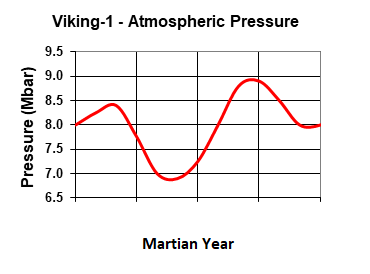Mysterious Mars
As a
kid, I was fixated on Mars. I still
am. This discussion question fills
in some gaps about the red planet not covered in the class material.
Part 1 –
Mars comes in opposition every 2.135 years.
When will the next opposition of Mars occur and how far away will it be
(in AU’s)? However, the orbit of
Mars is much more eccentric than the orbit of the Earth.
As a result, the Earth-Mars distance varies from one opposition to the
next. What is the closest Mars gets
to us (in AU’s, at opposition)?
When did this last occur and when will it occur again?
The next opposition of Mars will occur in October
13, 2020 when it will be .418 AU away from us.
Click
here
There was a great opposition of Mars on August 27, 2003 when Mars was
only .373 AU from us. The next time
Mars gets this close to us will be in the year 2287 so don’t hold your breath.
Part 2 –
Mars has a tilt like the Earth, so it has seasons (which last longer on Mars).
Mars also has two ice caps that change with the seasons (like they do on
the Earth). Describe the
composition and structure of these ice caps and how they change throughout the
Martian year.
In your answer, explain some major differences between the northern cap
and the southern cap.
In their respective winter, the Martian ice caps are mainly frozen water with a
thinner cap of frozen carbon dioxide (dry ice).
As a result, they grow in size.
During the spring, much of the surface water ice and carbon dioxide sublimates (vaporizes) and
becomes part of the atmosphere. As a result, they shrink considerably in size, creating global winds that blow from pole to
pole. One interesting thing about the caps
is that dust in the atmosphere get picked up within these winds and eventually
gets incorporated within the ice at the poles, creating a layered structure
(which look like tree rings). In the spring, when the ice gets vaporized,
the dust remains ... creating patterns and dunes.
This is the summer
north cap (at its minimum). The white area is water ice and the dark area
are dunes created from the dust that was brought in when ice was accumulating in
the winter.
The major differences are: The northern cap is much physically larger in area (both in summer and winter ... and no one knows exactly why). Another difference is the southern cap can retain much more carbon dioxide (even some in summer) since it is geographically higher and therefore, much colder. It also undergoes a much bigger change in size from winter to summer. Finally, each cap (even at its minimum) is still quite thick ... extending to a depth of 2-3 km.
Difference
between sizes of the southern ice cap from winter to summer
Part 3 –
The surface pressure of Mars can vary by as much as 30% throughout the Martian
year (as measured by the surface landers, see graph).

Your job is to explain why this occurs.
Bonus points if you can include why the two peaks are not equal heights and why
the two valleys are not the at the same low point.
If you got the last question 100% correct, this
one should make perfect sense. It all has to do with gas (water ice &
carbon dioxide) that do a seasonal dance between the ice caps and atmosphere.
When one pole is going through their winter, these gasses are taken out of the
atmosphere and the atmospheric pressure drops. Keep in mind that the
seasons are revered in each hemisphere (i.e.. when one pole is experiencing
winter, the other pole is experiencing summer).
Bonus points: So why the differences in peaks and valleys? That all has to do with the differences between the two ice caps.
The first maximum is about late spring in the NH. You would expect the northern ice caps to sublimate and put more water vapor in the atmosphere. The other maximum occurs at late fall in the NH. However, this is during late spring in the SH so you not only get water vapor but lots more CO2 sublimating out of the southern cap (remember higher elevation means it is much colder). This gives an even higher maximum in atmospheric pressure. All you need to do is reverse the reasoning to explain the minimums.
Part 4 –
Teach me something about Mars that interests you which is NOT already covered in
this discussion or in the web notes.
As always, please include your sources.
Answers vary